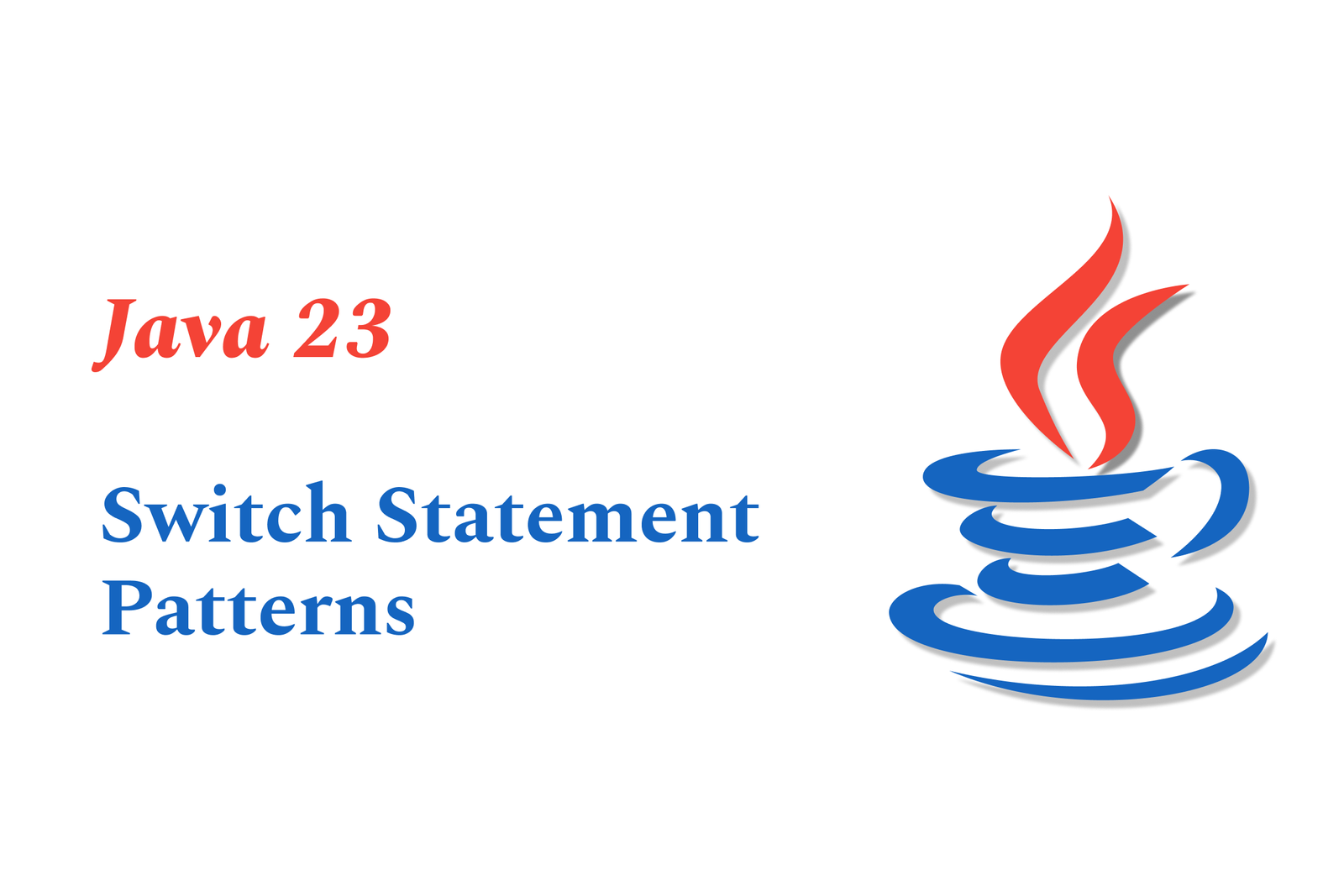Java 23 Switch Statement Patterns
Java 23 enhances switch statements with pattern matching, allowing concise, expressive type checks—including primitives—and guarded cases. This feature simplifies code by combining type testing, casting, and conditions directly within switch cases for clearer, safer control flow.
Java 23 Switch Statement Patterns
1 ) Introduction to Pattern Matching in Java
Pattern matching enhances Java's type checking and data extraction capabilities by testing an expression against specific criteria. From Java 16 onwards, type patterns simplified instanceof usage by combining type checking and casting in one step.
2 ) Evolution from if else Instanceof to Switch Patterns
Before, multiple instanceof checks required cumbersome if else chains. Switch statements with pattern matching now allow cleaner, more readable, and more performant code by matching cases on types and conditions directly.
3 ) Pattern Matching with Switch in Java 21
Java 21 introduced full support for pattern matching within switch statements and expressions, moving beyond constant value matching to sophisticated type and structure based checks. Example:
java
return switch (obj) {
case String s > s;
case Integer i > Integer.toString(i);
default > “n/a”;
};
4 ) Guarded Patterns with `when` Clauses
You can apply additional Boolean conditions to patterns in switch cases via `when` clauses to create guarded patterns, enhancing control flow precision. Example:
java
switch (obj) {
case String s when s.length() == 1 > System.out.println("Short: " + s);
case String s > System.out.println(s);
default > System.out.println("Not a string");
}
5 ) Handling Null Values in Switch Patterns
Traditional switches struggle with null selectors, but pattern matching in switch can explicitly incorporate `case null` to manage null values gracefully, improving robustness.
6 ) Primitive Patterns and Java 23 Enhancements
Java 23 introduces primitive type patterns that restore balance to the pattern matching ecosystem, enabling similar concise, expressive checks on primitives like `int`, `double`, and others in switch constructs.
7 ) Nested, Record, and Unnamed Patterns
Advanced pattern forms like nested patterns, record patterns (matching on record components), and unnamed patterns facilitate deep, structured data processing directly within switch statements.
8 ) Performance and Readability Benefits
Pattern matching in switch constructs not only clarifies intent and reduces boilerplate but also allows JVM optimizations potentially leading to O(1 ) dispatch time compared to O(n) for if else chains.
9 ) Scope and Case Dominance Rules
When using pattern variables, their scope is constrained to the matched case, and the compiler applies dominance rules to prevent unreachable patterns, enforcing cleaner code structures.
10 ) Future Directions for Pattern Matching in Java
Upcoming enhancements may include deconstruction patterns, static and instance patterns, and more powerful logical pattern combinations (AND, OR), pushing pattern matching towards a more expressive and flexible paradigm.
Summary:
Java 23's switch statement patterns represent the maturation of pattern matching in Java, extending from reference types to primitives, and enabling guarded, nested, and record based cases. This evolution simplifies code, improves performance, and sets the stage for even richer pattern mechanisms in future releases.
https://justacademy.in/news-detail/react-native?s-performance-gains-on-android-15
https://justacademy.in/news-detail/best-new-android-apps-released-this-month
https://justacademy.in/news-detail/ios-19-haptic-feedback-improvements-explored
https://justacademy.in/news-detail/top-animation-packages-for-flutter
https://justacademy.in/news-detail/java-in-blockchain-smart-contracts:-use-cases
Related Posts
In 2025, top Angular libraries offer modern, feature-rich components and tools for building dynamic web apps. From powerful data grids to low-code platforms like UI Bakery, these libraries enhance development speed, UI design, and scalability, making them essential for Angular developers.
Migrating from AngularJS to Angular 17 involves gradually upgrading your app by running both frameworks together using tools like ngUpgrade, rewriting components in TypeScript, and adopting Angular’s modern architecture to enhance performance, maintainability, and long-term support.
Angular state management tools help organize and handle app data efficiently, improving scalability and maintainability. Popular options include NgRx for robust, RxJS-based patterns, and newer Signal Store solutions that offer simpler, reactive approaches integrated tightly with Angular’s latest features.
RxJS in Angular empowers developers to manage asynchronous data streams with powerful operators like `forkJoin`, `combineLatest`, and `zip`. Mastering these key operators in 2025 is essential for building efficient, reactive applications that handle complex event sequences seamlessly.
Angular performance optimization in 2025 focuses on improving app speed and responsiveness by using techniques like OnPush change detection, lazy loading, efficient data caching, and AOT compilation. These practices reduce load times, enhance user experience, and ensure scalable, fast Angular applications.
In 2025, Angular remains preferred for large-scale, enterprise apps with its robust, all-in-one framework, while Vue attracts developers seeking simplicity and fast development for smaller projects. Both frameworks excel, with choice driven by project needs and team expertise.
Angular Signals are a new reactive primitive in Angular 16 that enable fine-grained, efficient change detection by automatically tracking dependencies and updating only affected parts of the UI. They simplify state management and boost app performance, revolutionizing Angular's reactivity model.
Angular interview questions to prepare in 2025 focus on core concepts like components, directives, data binding, routing, and dependency injection, along with TypeScript mastery and latest Angular features to ensure strong practical knowledge for building scalable, efficient web applications.
AngularJS reached its official end of support in January 2022, meaning no further updates or security patches. To ensure app security and performance, developers should consider migrating to modern Angular versions or seek third-party long-term support options if immediate migration isn’t possible.
The Angular Roadmap 2025 highlights upcoming features focused on improving developer experience and performance, including zoneless Angular, Signals integration, enhanced Forms, async data handling, improved HMR, and expanded Angular Material/CDK enhancements, driving modern, efficient web app development.










